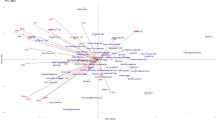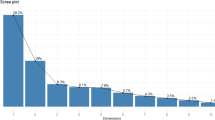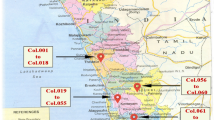Abstract
Red head cabbage is among the significant winter vegetables largely produced in various parts of the world and Turkey. This study was conducted for morphological characterization of red head cabbage populations supplied from different gene banks of the world and to determine similarities and differences among the genotypes. Morphological characteristics of the genotypes were defined in accordance with the criteria of International Union for the Protection of New Varieties of Plants (UPOV) and International Plant Genetic Resources Institute (IBPGR). Principle component analysis (PCA) was used to investigate variations in 27 traits of red head cabbage populations. The first nine principal component axes accounted for 73.96% of the total multivariate variation among the populations. The first principal component (PC1) were the most important component and red head cabbage traits that constitute the PC1 (plant diameter, weight of head, length of head, diameter of head and head volume) were in fact the characteristics considered by breeders to be of greatest importance in cabbage breeding. Experimental data were also subjected to cluster analysis and it was observed that red head cabbage populations were clustered in eight groups. The dendrogram generated to assess the similarities of the populations revealed a high variation among the genotypes. These results are very important for hybrid red head cabbage breeding studies and can help breeders to select genotypes with the desired traits in redhead cabbage.

Similar content being viewed by others
References
Arslanoglu F, Aytac S, Karaca Oner E (2011) Morphological characterization of the local potato (Solanum tuberosum L.) genotypes collected from the Eastern Black Sea region of Turkey. Afr J Biotechnol 10(6):922–932
Astley D, Pinnegar A (2003) Progress of the Brassica rapa group in the GENRES CT99 109-112 Project. In: Maggioni L, Thomas G, Lipman E (eds) Report of a working group on Brassica. Extraordinary meeting, held jointly with the third coordination meeting of the EU project GENRES 109-112, 8–9 February 2002, Vila Real, Portugal. IPGRI, Rome, Italy, p 59–62
Balkaya A, Ergun A (2008) Diversity and use of pinto bean (Phaseolus vulgaris) populations from Samsun, Turkey. N Z J Crop Hortic Sci 36:189–197
Balkaya A, Yanmaz R, Apaydin A, Kar H (2005) Morphological characterization of white head cabbage (Brassica oleracea var. capitata subvar. alba) genotypes in Turkey. N Z J Crop Hortic Sci 33:333–341
Balkaya A, Yanmaz R, Ozbakir M (2009) Evaluation of variation in seed characters in Turkish winter squash (Cucurbita maxima Duch.) populations. N Z J Crop Hortic Sci 37(3):167–178
Balkaya A, Ozbakir M, Kurtar E (2010) The phenotypic and fruit characterization of winter squash (Cucurbita maxima) populations from the Black Sea region of Turkey. Afr J Biotechnol 9(2):152–162
Balkaya A, Sarıbaş Ş, Özgen T (2016) Türkiyede kışlık sebze türlerinin tarımsal üretimdeki yeri ve önemi. Türk Tohumcular Birliği Derg 5(20):8–12
Cartea ME, Picoaga A, Soengas P, Ordas A (2002) Morphological characterization of kale populations from north-western Spain. Euphytica 129:25–32
Cervenski J, Gvozdanovic-Varga J, Glogovac S, Dragin S (2011a) Variability of characteristics in new experimental hybrids of early cabbage (Brassica oleracea var. capitata L.). Afr J Biotechnol 10(59):12555–12560
Cervenski J, Gvozdanovic-Varga J, Glogovac S (2011b) Local cabbage (Brassica oleracea var. capitata L.) populations from Serbian Province of Vojvodina. Afr J Biotechnol 10(27):5281–5285
Escribano MR, Ron AM, Santalla M, Ferreira JJ (1991) Taxonomical relationship among common bean populations from northern Spain. Euphytica 76:1–6
Escribano MR, Santalla M, Casquero PA, Ron ADE (1998) Patterns of genetic diversity in landraces of common bean (Phaseolus vulgaris L.) from Galicia. Plant Breed 117:49–56
Gaafar AA, Aly HF, Salama ZA, Mahmoud KM (2014) Characterizing the antioxidant and anticancer properties of secondary metabolites from red and white cabbages Brassica oleracea L. var. capitata. World J Pharm Res 3(4):171–186
Gadi J, Chakraborty NR, Imam Z (2020) Genetic diversity analysis in Indian mustard (Brassica juncea). J Pharmacogn Phytochem 9(1):952–955
Hair JR, Anderson RE, Tatham RL, Black WC (1995) Multivariate data analysis with readings, 4th edn. Prentice-Hall, Englewood Cliffs
Hartings H, Berardo N, Mazzinelli GF, Valoti P, Verderio A, Motto M (2008) Assessment of genetic diversity and relationships among maize (Zea mays L.) Italian landraces by morphological traits and AFLP profiling. Theor Appl Genet 117(6):831–842
Hu H, Wang J, Hu T, Wang W, Wei Q, Bao C (2020) Phenotypic diversity of non-heading Chinese cabbage germplasm resources in Zhejiang province. Int J Hortic 10(3):19–27
Hunter BR (1993) Science based identification of plant genetic material. CSSA, Intellectual propert rights: protection of plant materials. Special Publication No. 21, p 93–99
IBPGR (1990) Descriptors for brassica and raphanus. International Board for plant genetic resources, Rome, 51 p
Ilyas M, Shabbır G, Rabbanı MA, Malık SI, Cheema NM, Ansar M, Jan SA (2018) Genetic divergence İn Brassıca napus L. germplasm as determined by quantitative attributes. Pak J Bot 50(3):1039–1045
Jacob JA, Mahal HS, Mukherjee T, Kapoor S (2011) Free radical reactions with the extract of brassica family. Food Chem 129(3):1132–1138
Jeffers JNR (1967) Two cases studies in the application of principal component analysis. Appl Stat 16:225–236
Kar H, Karaağaç O, Kibar B, Apaydın, A (2008) Beyaz baş lahanada geliştirilen yerli F1 hibrit çeşit adaylarının morfolojik özelliklerinin tanımlanması. VII. Sebze Tarımı Sempozyumu, 26–29 Ağustos, Yalova
Karaağaç O (2006) Bafra Kırmızı Biber Gen Kaynaklarının (Capsicum annuum var. conoides Mill). Karakterizasyonu Ve Değerlendirilmesi. Yüksek Lisans Tezi. Tezi, OMÜ Fen Bilimleri Enstitüsü, Samsun
Kaygısız Aşçıoğul T (2009) Bazı lahana genotiplerinin morfolojik ve moleküler tanımlanmasına yönelik araştırmalar. Yüksek Lisans Tezi, Ege Üniversitesi, Fen Bilimleri Enstitüsü, İzmir, p 94 s
Kibar B, Karaağaç O, Kar H (2016) Determination of morphological variability among cabbage (Brassica oleracea var. capitata L.) hybrids and their parents. Univ J Inst Sci Technol 6(1):31–44
Liu J, Liu L, Hou N, Zhang A, Liu C (2007) Genetic diversity of wheat gene pool of recurrent selection assessed by microsatellite markers and morphological traits. Euphytica 155:249–258
Loncaric A, Marcek T, Šubaric D, Jozinovic A, Babic J, Milicevic B, Sinkovic K, Šubaric D, Ackar D (2020) Comparative evaluation of bioactive compounds and volatile profile of white cabbages. Molecules 25:3696
Mohammadi SA, Prasanna BM (2003) Analysis of genetic diversity in crop plants-salient statistical tools and considerations. Crop Sci 43:1235–1248
Özdamar K (2004) Paket Programlar ile Đstatiksel Veri Analizi (Çok Değişkenli Analizler). 5. Baskı. Kaan Kitapevi, p 528s
Parkash C, Kumar S, Singh R, Kumar A, Kumar S, Dey SS, Bhatia R, Kumar R (2018) ‘Ogura’-based ‘CMS’ lines with different nuclear backgrounds of cabbage revealed substantial diversity at morphological and molecular levels. 3 Biotech 8:27
Parvin E, Mahmud F, Bhuiyan MSR, Haque MM (2019) Multivariate analysis of genetic variation in rapeseed (Brassica Napus L.). Agric Food Sci Res 6(1):1–8
Rohlf FJ (1992) NTSYS-pc. Numerical taxonomy and multivariate analysis system. Version 1.70. Exeter Software, Setauket, NY
Salim MMR, Rashid MH, Hossain MM, Zakaria M (2018) Morphological characterization of tomato (Solanum lycopersicum L.) genotypes. J Saudi Soc Agric Sci. https://doi.org/10.1016/j.jssas.2018.11.001
Smith JSC, Smith OS (1989) The description and assessment of distances between inbred lines of maize: the utility of morphological, biochemical and genetic descriptors and a scheme fort He Testing of distinctiveness between Inbred Lines. Maydica 34:151–161
Smykal P, Hybl M, Corander J, Jarkovsky J, Flavell AJ, Griga M (2008) Genetic diversity and population structure of pea (Pisum sativum L.) varieties derived from combined retrotransposon, microsatellite and morphological marker analysis. Theor Appl Genet 117(3):413–424
Sneath PHA, Sokal RR (1973) Numerical taxonomy. W.H. Freman Co., San Francisco
Tan Ş (2005) Bitki Islahında İstatistik ve Genetik Metotlar. Ege Tarımsal Araştırma Enstitüsü Müdürlüğü Yayın No. 121, Menemen/İzmir, p s.129–145
Tanaka N, Niikura S (2003) Characterization of Early Maturing F1 Hybrid Varieties in Cabbage (Brassica oleracea L.). Breed Sci 53(4):325–333
Tariq H, Khan FA, Firdous H, Ullah Z, Javaid RA, Vaseer SG, Zulfiqar M (2020) Cluster analysis of morphological and yield attributing trait of Brassica napus genotypes. Life Sci J 17(8):18–21
TUİK (2019) Turkish Statistical Institute statistical data. http://www.tuik.gov.tr/bitkiselapp/bitkisel.zul
UPOV (2004) Cabbage, TG/48/7. Guidelines for the conduct of tests for distinctness, uniformity and stability. International Union for the Protection of New Varieties of Plants, Geneva, 36 p
Vanlalneihi B, Saha P, Kalia P, Singh S, Saha ND, Kundu A (2020) Genetic and principal component analysis for agro-morphological traits, bioactive compounds, antioxidant activity variation in breeding lines of early Indian cauliflower and their suitability for breeding. J Hortic Sci Biotechnol 95(1):93–105
WeiDong S, ZhenDong C, GuiXiong N, HaiLing L, HongWei K, AiPei W (2019) Evaluation of Chinese flowering cabbage by principal component and cluster analysis. Acta Agric Jiangxi 31(9):46–49
Yousuf M, Ajmal SU, Munir M, Ghafoor A (2011) Genetic diversity analysis for agro-morphological and seed quality traits in rapeseed (Brassica campestris L.). Pak J Bot 43(2):1195–1203
Zhang X, Blair MW, Wang S (2008) Genetic diversity of Chinese common bean (Phaseolus vulgaris L.) landraces assessed with simple sequence repeat markers. Theor Appl Genet 117:629–640
Acknowledgements
The study was supported by The Scientific and Technological Research Council of Turkey (TUBITAK) Project No. 117G002 (Line and/or Variety Development Project in Winter Vegetable Growing).
Author information
Authors and Affiliations
Corresponding author
Additional information
Publisher’s Note
Springer Nature remains neutral with regard to jurisdictional claims in published maps and institutional affiliations.
Rights and permissions
About this article
Cite this article
Özer, M.Ö. Morphological variability of red head cabbage (Brassica oleracea L. var. capitata L. subvar. rubra) populations. Genet Resour Crop Evol 68, 1033–1043 (2021). https://doi.org/10.1007/s10722-020-01046-8
Received:
Accepted:
Published:
Issue Date:
DOI: https://doi.org/10.1007/s10722-020-01046-8




